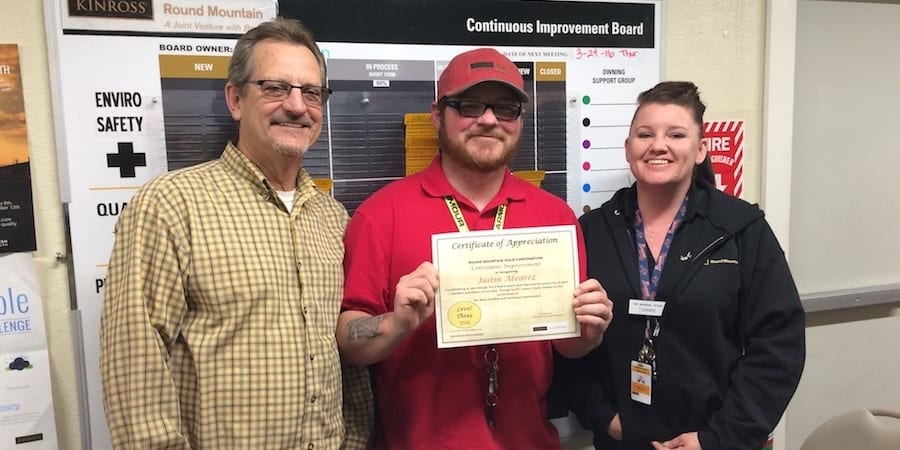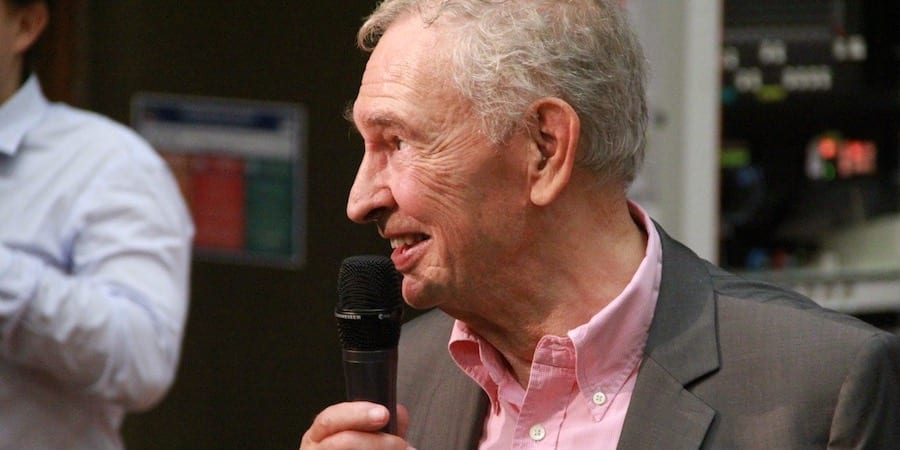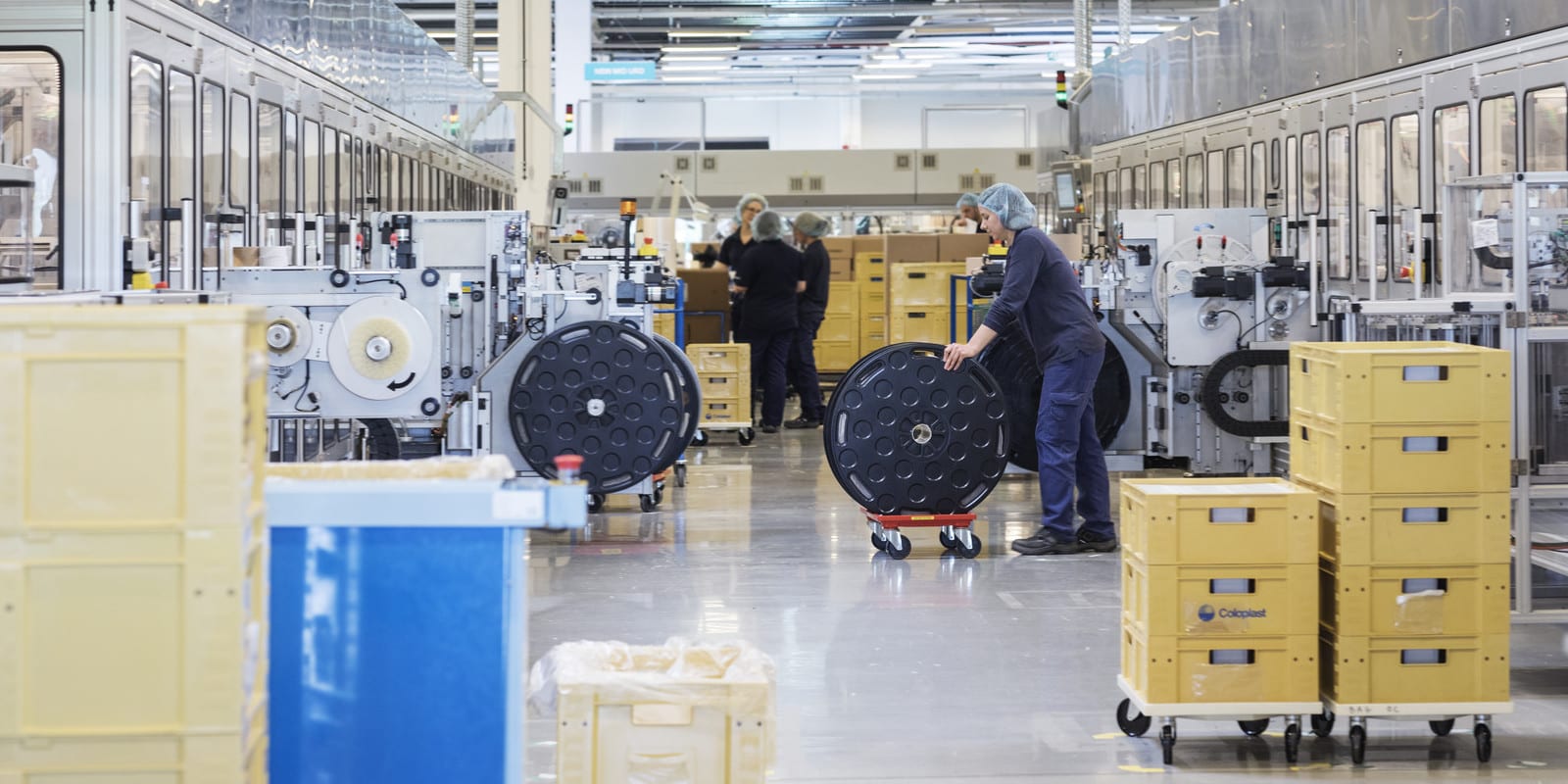
How a Kinross mine drives lean thinking using CI boards
FEATURE – The Continuous Improvements Boards at the Round Mountain mining site have been critical to shifting the company's culture... the secret, it turns out, is always providing feedback on people's suggestions.
Words: Deanna Hall, Continuous Improvement Facilitator, Kinross Gold Corporation – Round Mountain, Nevada
Henry David Thoreau, a 19th-century American essayist and philosopher, once wrote: "The greatest compliment that was ever paid me was when one asked me what I thought, and attended to my answer."
It's the last bit of that statement that really speaks to me. There is so much talk in the business world about listening to people, but the reality is that listening alone doesn't go very far. It's in acknowledging someone's ideas and in assessing and possibly implementing them that we earn people's trust and support. Indeed, when we asked our people at the Round Mountain mining site what they thought about our suggestions boxes – which we previously used to highlight and tackle safety issues – many of them said they liked them because of the feedback they received on their suggestions for improvement. It is not enough to install a suggestion box: if you don't engage with people, you won't get much done.
Even though many of our employees were happy with the suggestions boxes, we realized there was no reason to have the safety improvement activities separate from the rest of our continuous improvement efforts. That's when we decided to implement a standard process for people to submit their ideas: the CI boards. (We did, however, retain two different types of cards – the orange one is for safety idea, the yellow one for everything else.)
The inspiration for the boards came from Caterpillar through the Caterpillar Alliance program, but we have had to adjust them to our needs. For example, timelines are a bit harder for us to implement than they are for Caterpillar, where there are people in charge of managing boards and facilitating change full time.
THE PROBLEMS WE USE THE BOARD FOR

Everybody at Round Mountain can contribute to good change, if they wish to do so, from new hires to people who have been with us for a while. If they think they have an idea that can help us, we want to hear it. After all, who better than those carrying out the work can make suggestions on how to improve it?
Our system of boards on site have proved very successful at collecting and delivering on employee improvement ideas. This visual tool (visualization is the basic requirement of any group activity, including improvement) keeps track of all the ideas for improvements gathered across a team or department and then helps us to analyze the status of ongoing experiments and removal of waste.
We soon found out that setting expectations is fundamental. That's why we strive to help people understand what kind of problems we want to address on their cards: if there is a safety hazard that might cause immediate harm, for example, we don't want them to put it on a card, but to barricade the area and then implement the appropriate controls that will correct the hazard. We want our boards to carry improvements to the safety programs we already have in place, or improvements to a given task that can help us carry it out more safely and efficiently. In the same way, if someone runs out of an item or part, they should just reorder that item – not write it on board. We also stress that the board is not a way to say what others should do, or to point the finger at someone we are upset with – instead, we attempt to work together and strategize as cross-functional teams to come up with the best possible solution.
For any idea for realistic improvements that have the potential to improve our process and that departments can implement themselves there will always be a place on the CI Board. That's how we get our people to think together.
When a Round Mountain employee has an idea, they grab a card, write their name and the date on it, and place it in the "New" column in the section with the KPI they are trying to influence (Safety; Environmental, Production, Quality, and Cost savings). The right side of the board shows who is part of the team in that particular department, so that if people want to contact others to get help or ask a question, they know who to turn to. The Board Owner is also listed there.
During our meetings (we strive for a monthly cadence), we go through the cards and the idea's Originator has the opportunity to explain his suggestion more in depth. People have learned to come to the meeting prepared – they often bring extra research and data to support their idea (it's hard to fit everything on a tiny card sometimes).
We then discuss the suggestion. This is moderated and facilitated by the Board Owner, who is neutral and ensures everyone in the team treats the suggestion as if it were their own. Even if an idea is silly, we don't say it out loud. The Board Owner role is really all about facilitation: they schedule the meeting, invite the people, determine what happens when people are gathered around the board.
The summary of the minutes of the meeting is transferred on a spreadsheet (this came in later to avoid cards being taken off the board), so that all the information on a card is also available elsewhere. After the meeting, the Board Owner also emails the steering team with the updated spreadsheet and the action items that have been assigned, which helps with keeping people accountable and with documenting our projects.
During the meetings, we go through every single card and always try to assign a Card Owner for each suggestion. This might or might not be the idea's Originator, depending on whether that individual has the resources and ability to get things done (at times with the help of the steering team).
When assigned, the card is moved to the "In Process column" (which has three sub-sections – 25%, 50%, 75% - to give us a sense of the progress made). If it's a quick and easy idea, we try to get it at least moving by the next meeting. We regularly check where we are with each card, which is a way for us to keep people accountable. If there is no update on a card for a while, we know there is a problem, or that perhaps we have selected the wrong Card Owner. (We also have a "Long Term" column for those ideas that are important but will require time to develop and implement.) Importantly, prior to implementing ideas, we ensure that consensus in the group is achieved, as we don't want to negatively impact another department or crew because we simply failed to communicate a change.
The last three columns on our CI Boards are "Completed", "Review" and "Closed". "Completed" refers to an idea that has been implemented and for which people have been awarded; "Closed" means that we have not implemented the idea (the card is not actually closed until we have followed up with the Originator and told them why); "Review" only refers to those instances in which we are in limbo between Completed and Closed, and the card progress has become stagnant (calling for a new Card Owner).
Contribution gets recognition, even though we don't utilize the reward system in all departments. We have discovered that some people will contribute their ideas to get a reward, while others don't want the reward because they feel that contributing is their duty (and, increasingly, because they recognize it benefits them). In those areas, we normally observe that the CI culture has evolved into more sustainable practices.
Our rewards range from $3 to $250: the more ideas you contribute, the more you can accept in reward. Sometimes it is the ownership you show of the problem that determines the amount you receive. Even if an idea doesn't work out, we don't take back the reward. We also reward someone after we decided to do something different from what they originally suggested, because we want to foster continuous participation and because there is a chance we would not have found out about the initial problem without the individual raising it.

OWNING PROBLEMS
Back in 2012, we had "orphan" boards all over the place – we have high turnover of staff – which meant that the teams would often not meet for several months and that there would be a pile of cards to go through when a meeting did occur. Batching really is bad! We therefore put together an internal post to ask people to volunteer to become Board Owners. We were pleased to see lots of people volunteering (we are also developing back-ups, who receive the same training the owners get).
It takes a very specific type of person to do the job: a change agent, a facilitator, someone who likes to run projects and is determined to drive improvement. As mentioned earlier, this can only happen if people make suggestions and if we address and follow up on them. We are very conscious about providing feedback quickly and trying to ensure the meetings take place regularly, because we know that if people are contributing to the board it means they have noticed a problem. We also encourage Owners to look at the boards on a daily basis, if anything to grab any orange cards and put them on top of the list (those are the safety issues, which normally take priority).
We believe communication is a two-way street, and this is something we mention all the time: people should be patient with board owners (because this is something extra they do on top of their regular jobs), but at the same time they are encouraged to follow up if they don't hear back from them for a month.
The biggest contribution that CI boards gave us is systematizing experimentation – in doing that, they ended up changing the culture at Round Mountain. They brought in accountability for managers, encouraging them to follow up on people's ideas: without feedback, the boards would fail... and everybody would know right away by looking at them. That's how powerful visualization is.
As little experiments pop up all over the place, people understand their ideas are being heard and the effect on morale is huge. I get goosebumps whenever we receive feedback from people: they know it's really happening. When our guys are sitting to have lunch and a picture of one of their colleagues, who suggested an improvement that was then implemented, appears on one of our TV screens, they might feel compelled to bring their own ideas forward. This sort of communication – coupled with the system of department-level awards we established to incentivize employees to participate and to reward value driven ideas – helps us keep the improvements going, at Round Mountain and in other Kinross sites. We also ask our people to hang out with cards in their pockets, so that they can hand one out to someone whenever, during a conversation or brainstorming session, an idea is brought up.
Too often it's the multi-million programs that get all the attention, but we believe that even the tiniest improvement is worth our managers' attention. Even money-wise, it all adds up. One of our supervisors once said: "Nothing is past ridiculous, put it on the board."
The CI Board process is about finding ways for people to contribute with self-worth to work worth doing. It has been about helping them work with their heads and hearts, as well as with their hands and feet.
These days, everybody in the mining site has an opportunity to influence positive change and get involved. In 2016 we received 604 ideas from our staff, which is testament to how much the culture at Round Mountain has shifted. It is important to understand, however, that this has not happened because we use the boards... it's happened because of the experiments that the boards help us to manage and facilitate, and because we consistently provide feedback on the suggestions people make. That, to us, is the real meaning of "respect for people".
For a case study on the lean transformation at Round Mountain, click here
THE AUTHOR

Read more


INTERVIEW – Having started to explore TPS in the mid-1970s, Freddy Ballé is one of the great pioneers of our movement. Here, he shares what he learned about Toyota over the past 40 years.


INTERVIEW – The Consorci Sanitari del Garraf, a Catalan hospital PL has come to know well over the past few years, just won an Honorable Mention award at the World Hospital Congress.


SERIES – In the final article in their series on lean process development, the authors discuss what it takes to get started with their 6CON process development model.


CASE STUDY – The author looks back at the impressive lean transformation of the Hungarian plant of Coloplast, a Danish company offering medical devices and services.

